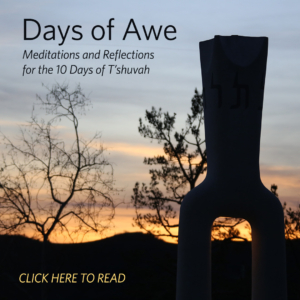From now through Yom Kippur, each of our Daily Kavanot will feature a piece written by our clergy on the themes and traditions of the High Holy Days. Each of these pieces can be found in Days of Awe, our High Holy Day Machzor supplement.
On the Throne
By Rabbi Sari Laufer
There is a beautiful teaching in the Talmud which imagines God in a moment of prayer. For what—the rabbis wonder—does God pray? The answer: “May it be My will that My mercy will overcome My anger (towards Israel), and may My mercy prevail over My other attributes and may I deal with My children with the quality of mercy, and may I stop short of the limit of strict justice.” God prays that God will have mercy on us all. These attributes—justice and mercy—are the work of the High Holy Days.
 When I have been asked to succinctly explain the High Holy Days to someone unfamiliar, I have said that Rosh Hashanah is a festive day, a celebration to kick off the New Year. For Yom Kippur, though, words like somber, solemn, and reflective come to mind. It is, in some ways, a strange shift, going from joy to solemnity. So often, our tradition guides us the other way; we are more often taught how to move—as our Psalms teach—from mourning to dancing. I have often wondered why we flip the script for these, our most sacred days.
When I have been asked to succinctly explain the High Holy Days to someone unfamiliar, I have said that Rosh Hashanah is a festive day, a celebration to kick off the New Year. For Yom Kippur, though, words like somber, solemn, and reflective come to mind. It is, in some ways, a strange shift, going from joy to solemnity. So often, our tradition guides us the other way; we are more often taught how to move—as our Psalms teach—from mourning to dancing. I have often wondered why we flip the script for these, our most sacred days.
Raised in the Ashkenazi tradition, the Unetaneh Tokef, with its litany of mortality and dramatic musical setting, was a central part of my High Holy Day experience, and particularly my Rosh Hashanah prayers. This liturgical poem, called a piyyut, imagines Rosh Hashanah—our festive New Year—as a trial. In the “opening arguments,” humanity is called to account before God, and rather than the “Oye! Oye!” of the Supreme Court, an angelic tribunal calls out: “Hineh Yom HaDin!“—Today is the day of judgment!
When the shofar sounds on Rosh Hashanah, the Judge retreats to Their chambers; we are granted a continuance, told that the verdict will be returned in 10 days. But perhaps unlike a regular litigant, our tradition believes work that we do in those 10 days has the potential to impact the verdict. And so, we are meant to—in these days,—turn our focus to our most significant relationships; we are meant to note the ruptures—large and small—and begin the hard work of repair. T’shuvah—repentance—is a process; it is not easily achieved. Nonetheless, we are meant to take a deep breath and begin.
Because, the hope is that when we stand trembling and vulnerable before God on Yom Kippur, our sincere attempts at t’shuvah, our prayers and introspection, and our recommitment to charitable giving and works of justice will have moved God from the throne of justice to the throne of mercy. And that is, our tradition says, cause for celebration. While the sound of the shofar on Rosh Hashanah is meant to sound the alarm, the final blast on Yom Kippur is the sound of new beginnings, grounded in love and mercy.
And so, as we begin these ten days of reflection, I invite God’s prayer to become our own: May it be our will that our mercy and forgiveness will overcome our anger and resentment, and may our mercy prevail over our other attributes …
And, may we be blessed with mercy, love, and wholeness in 5784.
